No surprises!
I posted my first Mason bee update on 25 March and I was really satisfied that I had attracted Osmia to my new Mason bee houses and I hoped to gather a bit of data on what might be suitable spots to situate Mason bee houses and what sized holes they preferred.

Firstly, no surprises, it looks like in France, at least, the bees prefer a sunny position. Out of the first three new hotels that were put up, it was the one on the wall in the front garden, with the morning sun, that attracted the most bees.
The bamboo canes had been chosen to give a diameter of 6mm to 1cm. I think the smaller diameter was favoured but my task was complicated as a potter wasp decided to use the hotel too. The potter wasp is responsible for the filling of the larger hole in the picture and the open holes are where the wasps have already vacated. I presume some of the other holes may hold wasp larvae.
The Bee hotel in the plum tree that received only dappled sunlight through its branches has Osmia and some other insects nesting but like the one under the willow at the bottom of the garden received fewer Osmia than the sunny hotel.
The bees arrive!
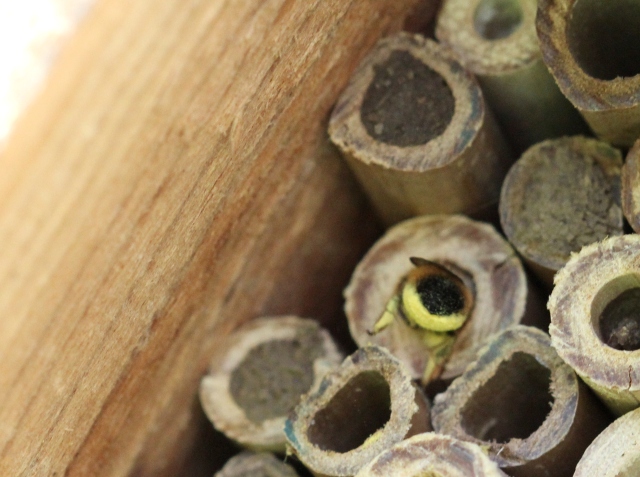
Keeping on track, not only did my original hanging house hatch out last year’s Osmia cornuta and have some more bamboo canes re-occupied but the new neighbouring one on the wall was even better received.

The O. cornuta preferred the new nest on the wall either because it was sunnier or because it was fixed securely to the wall rather than swinging on the branch of the lilac.
And then a second variety!

I had first seen the O. cornuta males around the old nest box at the beginning of March but in April I spotted another species of male Osmia in the garden.
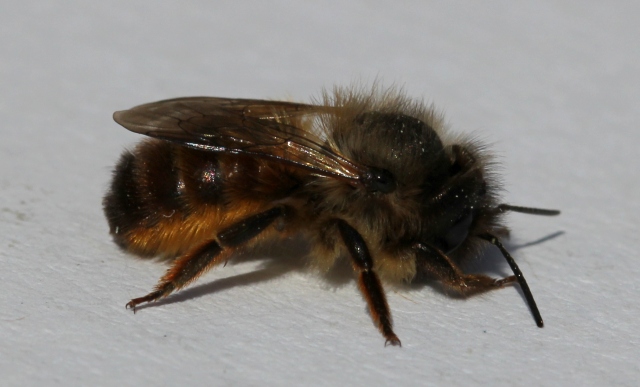
The Osmia rufa are not as brightly coloured as the O.cornuta and hatch out and fly later. I had never noticed them in the garden before.
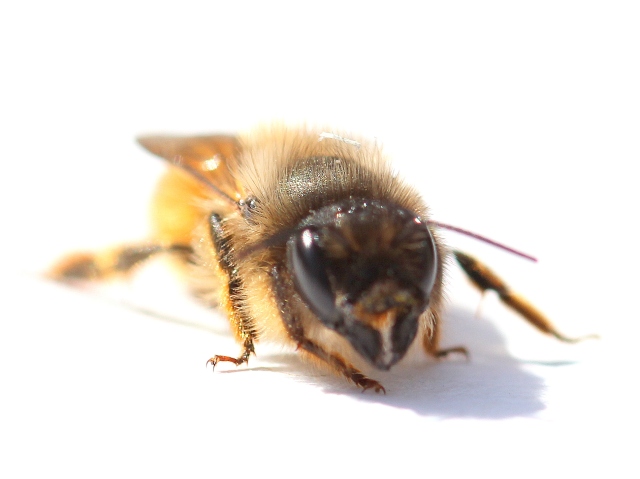
Both the O. rufa and the O.cornuta have curious prongs on their heads just under their antenna. The prongs are used to tamp in the mud they bring to seal their nest.

With two species of Osmia nesting in the hotels my husband became concerned that they would run out of holes or feel overcrowded so he hastily built a fourth hotel to go on an outbuilding wall that receives the sun all day long.
The third Osmia provides lots of entertainment in the summertime!
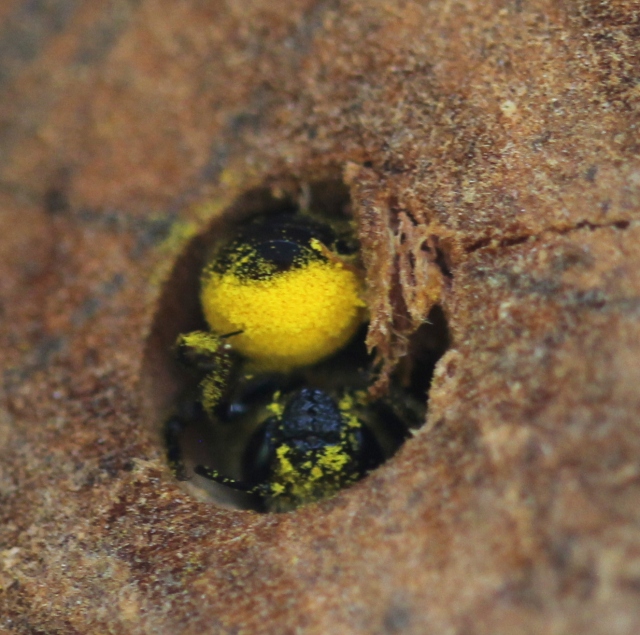
The Osmia leiana were the next arrivals in May and stayed around well into July. These little bees really put everything into building their nests. Gradually they fill the holes, cell by cell, and you can get a better look at all the action as they complete the last one or two compartments. I had now three species of Osmia nesting!

The Osmia leiana is not so colourful as the other two Osmia but nested for a longer period and the females even slept overnight in the bamboo of the hotel.
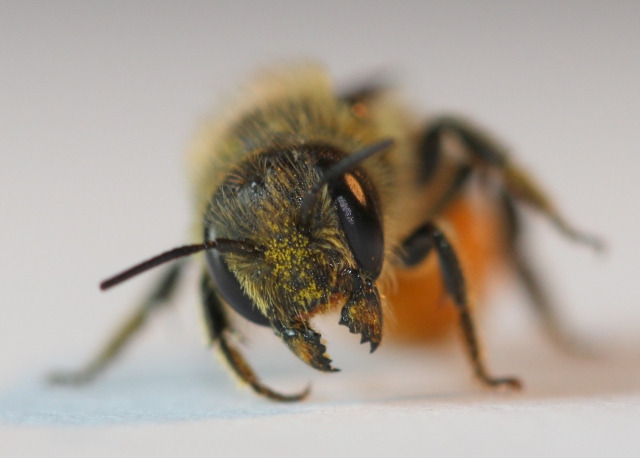
All the Osmia bees have strong mandibles to help them in building their nests. The O. leiana were prolific nesters and nested in all the bee hotels, even building a few nests in the hotels in the shade under the trees.
Then there is the Anthophora!

I have Anthophora plumipes nesting in the stone walls of the house and in May they were feeding on the blue Cerinthe in the front garden. I think this is a female of the light form that I have here starting off her nest in the holes of the trunk section of the bee hotel in the front garden.
The Anthophora have nested in the bored wooden holes in the cut tree trunks of the bee hotel on the out building too. They nest deep inside the holes but their presence is noticeable as they leave “paths” of sawdust on the bottom of the holes. They do this in the holes in the house walls but the “paths” in this case are like fine sand produced as they excavate their nests in the soft limestone.
And the Anthidium!
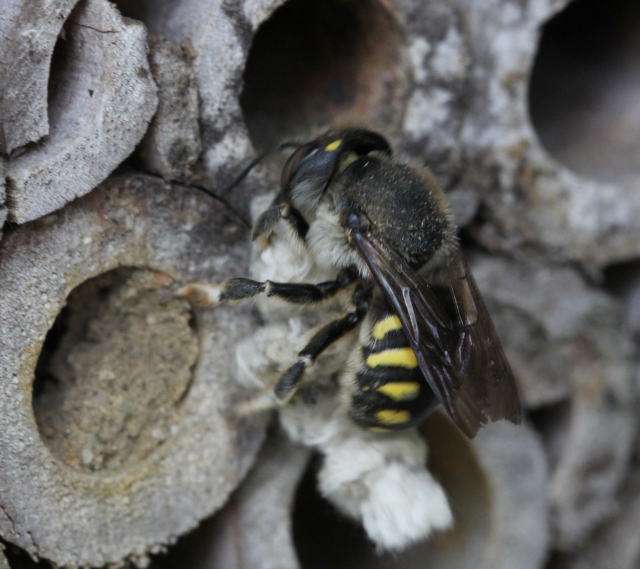
Another bee that nests in the bee hotels is the Anthidium. It is called the cotton bee in French for obvious reasons. She gathers the soft hairs from plants such as Stachys and brings them to the bamboo canes to make her nest.
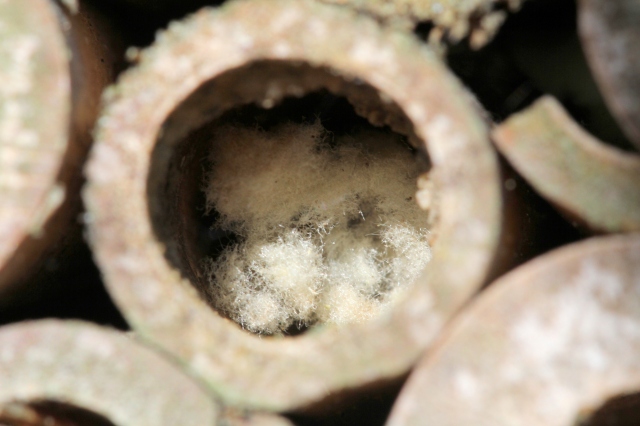
Frequently the nest is made deep into the hole and the cotton does not protrude so it is easy to miss their nests. It is really amazing to see the quality and quantity of cotton that this bee produces. I have a great attraction for this lovely bee.
Different Megachiles arrive!
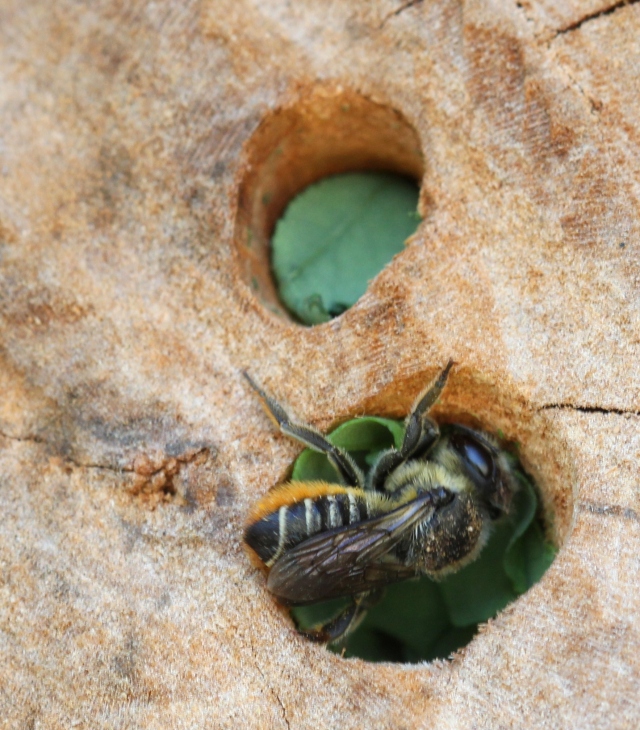
I had noticed suspicious pieces of leaves missing from plants in the garden during the summer and I had suspected leaf cutting bees but I had never caught any “in the act” so I could not be sure. So I was ecstatic when at the end of August I found them nesting in the sunny hotel on the outbuilding. They were so engaged in their task that they did not object to being watched. I found their determination and hard work fascinating to watch.
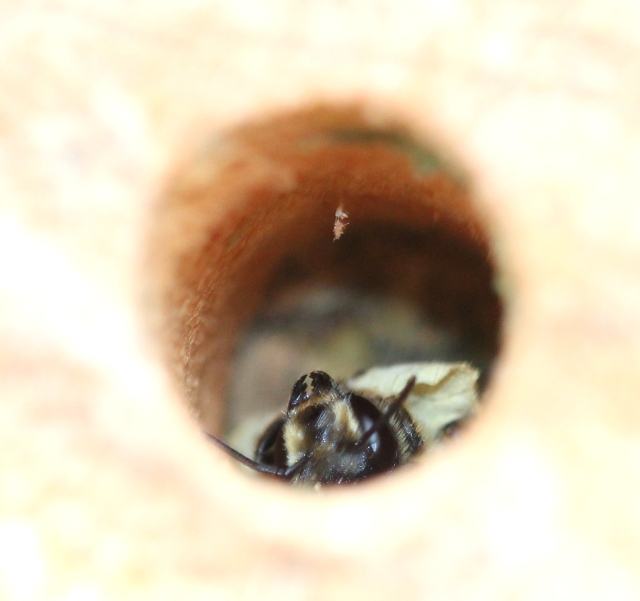
Some leaf cutting bees also nested in the hotel in the front garden but they were not early risers and I used to enjoy watching them wake up. This little bee had been so busy that she fell asleep on her back with a piece of leaf for a blanket. I took the photo at 9.49 a.m. and she was awake shortly after.
- Hole sealed with rose petal
At the beginning of September one of the leaf cutting bees used rose petals to make her nest. I did not see her but the end result was beautiful. I think they are most likely to be Megachile centuncularis.
Puzzles!
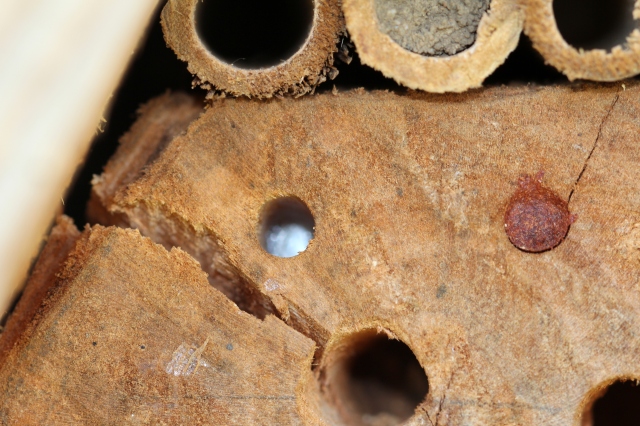
I am puzzled by this hole as it is shiny (I couldn’t manage to get a photograph to show the shine). Who has filled this hole? Is it another species of bee such as Colletes which line their underground nest with a cellophane? Or is it some other insect?
The other puzzle is how many different types of bees are nesting in the bee hotels? I have photographed six different species of solitary bees in this post. In addition, I think there is more than one species of Anthophora in the hotels and what about the ones I’ve missed?
Predators!
I am always on the look out for parasites and predators, which are numerous.
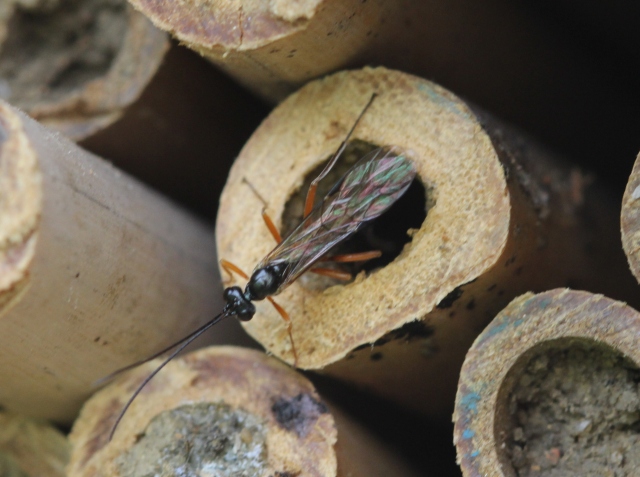
I was concerned when I saw this on the nests at the end of September.

This wasp came around at the end of September and seeing her putting her long tail into the bamboos I worried that she had been laying eggs in the bees nests. Apparently she prefers to parasitise wood boring insects but the larvae of the potter wasp which also used the bee hotel could also be a target.
And then there’s our lizards!

The lizards can be a bit of a pain as they insist on squeezing in between the bamboo and sometimes they will dislodge one causing it to fall. I replace it but I think a winter job will be to put a backing behind the bamboo to keep out the lizards. I comfort myself thinking that they will eat any little flies that might be lurking around.

I’m just not sure how vigilant my lizard guardians are but I can always hope.


Great photography and great information too. Thank you:-)
LikeLike
I’m glad you enjoyed the post, I feel the solitary bees are less supported than the honey bees and bumble bees.
LikeLike
What a fantastic post! I am so impressed that you have put this together and there are some adorable photos of the bees. I see you are doing a bit of whitebox photography now too. I guess the new camera has inspired you. I’m sorry I can’t answer any of your questions though.
LikeLike
I’ve had such a lot on this year I have not got around to making a white box. Another task for this winter! All I did was put them on a white piece of paper. I also need time to fiddle with my built in flash. I hope to get to the spring better prepared than I was this year.
LikeLike
Great photos , and yes bee boxes are far better in the sun than any other position. Keep up the good work 🙂 x
LikeLike
Thanks, looks like you had a great holiday trekking in Sikkim!
LikeLike
Yes we did thanks Sikkim and Nepal were great but came back with typhoid but all adds to the adventure 🙂
LikeLike
Typhoid can be very debilitating so take care and I hope you feel better soon.
LikeLike
Great post Amelia. You have made me think that I should make a bee hotel too! I have many different types of bee in the garden but I’ve never managed to identify them like you. I know the bees have made nests for themselves in the ground and house walls but it would be fun to see them more. Thank you for this, I have bamboo so it will be easy to make some hotels. Any other tips for how to construct the hotels?
LikeLike
My husband made ours see https://afrenchgarden.wordpress.com/2013/03/02/new-mason-bee-nests/. The Mark III model works the best as I think some different bees prefer the holes in the logs, like the Anthophora. So I think it is best to offer bamboo canes and drilled wood. The Anthophora are some of the cutest looking bees a bit like grey bumble bees. I am sure you would get lots of different varieties in your garden. The leaf cutters don’t do a lot of damage to the plants and are really lovely to watch.
LikeLike
I feel as though we have just had a peek at the guest book or hotel register of the finest bee hotel in France. How delightful that one of your guests chose rose petal linen 🙂
LikeLike
I love the analogy! They certainly make themselves comfortable.
LikeLike
Amelia,
I’m with Susan on the quality of the post…
here, the drilled block got the fullest treatment with the 8mm holes being filled first, then the 10 and 6 in no particular order.
Almost all were filled.
I’d need you or Susan here to identify the species though.
The “old fennel stalks” boxes that were placed beside the drilled block were barely used…
although the hole sizes were similar!
And I liked the rose petal filling too…
but I notice that some of your smaller drilled holes have a brick/tile dust filling…
I noticed this late in the season, too, despite being next to the bief where there is always wet mud for them to collect…
was it a particular species that used this technique, do you know?
I have four out of 20+ that are filled this way… all 6mm holes.
LikeLike
Actually, the drilled holes are all 6mm. but trying to drill the full 10mm. meant that the openings of some suffered unintended widening. I think I know which hole you mean and I have several like this, however, it is waxy looking in real life. It looks as if pollen or other plant material could be in the mixture. Some bamboo canes have been filled with the same mixture. I cannot be certain but it could be the O. leiana. I missed their arrival as I was in the UK for over a month this year from the middle of May.
LikeLike
Fascinating and fun post. The bees have been really busy and it is obvious that you have been equally busy.
LikeLike
Thank you. Actually, I was very busy this summer and I didn’t have as much time as anticipated to spend on my bee spotting but I hope to remedy this next year.
LikeLike
What a fantastic record of your insect visitors. You’ve made quite a good scientific report here, and it’s fascinating to see the changes over time. A most interesting post!!
LikeLike
Thank you. I did not expect so much action and I was unprepared for it. Next year I hope to be on hand and to keep a better record of what happens.
LikeLike
Love that pollen coated Osmia cornuta bottom disappearing into the bamboo. I shall include this post in our next Ealing beekeepers association newsletter.
LikeLike
The bees in the garden give me so much pleasure and I think more people could enjoy them by attracting them to their garden. Almost all the bees I see here live in the south of England too. Thank you for posting it in your beekeepers newsletter.
LikeLike
How fascinating! I loved seeing all of the different bees! Thank you 🙂 Dana
LikeLike
Glad to share my bees with you 🙂
LikeLike
Great post! Very informative.
LikeLike
Thank you 🙂
LikeLike
It’s amazing that you were able to attract so many bees to your garden, and even more so that you were able to identify them all. I’ve noticed that insects seem to like building nests under the eaves of houses, so I wonder if that influenced your bees. You got some excellent photos of them!
LikeLike
I have got an Anthidium nesting in a hole in a beam in a low part of the house which is like the eaves but the eaves of the main part are too high for me to see. There are a lot more bees in the garden now, those are just the ones nesting in the Mason bee houses and I know I’ve missed even more.
LikeLike
This really is a fabulous post. Love the bee that fell asleep under a leaf – and the lizard sleeping is precious, too. I have purchased two mason bee hotels to put out in my garden this next spring. I am so anxious! I had no idea so many bees could be attracted by a new place to nest.
LikeLike
I must admit I didn’t think mine would be so popular given there are lots of places they could go. I do have a lot of flowers that they can collect honey and nectar from. I also placed a stone I could stand on near the hotels to take photographs without damaging the border too much.
LikeLike
Fascinating post. The photo of the lizard sleeping in the bee hotel is priceless.
LikeLike
Our lizards provide us very high quality entertainment throughout the year 🙂
LikeLike
Brilliant, Amelia, what a huge success your Hotel chain is. Obviously far more popular than mere Bee & Bee accommodation… RH
LikeLike
Very good! 🙂
LikeLike
Lovely pics of big fat fuzzy bottoms squeezing into the nests. I echo RH, great success on B&B accommodation! I think these homes for nature should be encouraged in many more parks and gardens.
LikeLike
Good point. If there were more in parks it would let people who didn’t have gardens get a chance to watch the activity on sunny days.
LikeLike
Pollinator parks is a growing idea as they would be enriching for people living in cities – adults and children – and beneficial for wildlife too. That lovely summer hum and sight of bumble bees and butterflies is relaxing to hear and see, and all the different insects give children something to watch and talk about too. Your garden has inspired me!
LikeLike
This is really fascinating. Although, bees are making me nervous when they circle around me I did enjoy those beautifully taken pictures. Nice work.
LikeLike
I’m glad you liked the photographs. People are frequently nervous of bees which is such a shame. Bees will attack if you go near their nest or hive but that rarely occurs if you go for a walk in the garden or the country. Take a look at this light-hearted post https://afrenchgarden.wordpress.com/2013/07/18/do-bees-have-different-characters/. I have to get really close to the bees to take the photographs and I’ve never been stung. I am, of course, commenting on the areas I am familiar with and not the depths of the Amazonian jungle or further afield :).
LikeLike
I can’t believe I am going to say this, but they are all so cute. Bees really do rock!
LikeLike
I’m really glad you like them! I got so much fun watching all the comings and goings.
LikeLike
Excellent photos! It is nice to see that other critters can find shelter too within your bee hotels.
LikeLike
This is easily the most interesting post I have read lately. I love discovering new bees in my garden. My favourite so far is a type of Halictus bee, a tiny metallic green bee about the size of our common garden ant. I think if we had your little cotton gathering bee I would have a new favourite though.
When we bought this house the survey recommended we fill all the holes in the pointing. Needless to say, we haven’t – we much prefer the bees who inhabit them.
LikeLike
I have taken photographs of a little metallic bee in my garden but it is very tiny. I have a photograph inside of an annual poppy and it is the same size as the width of the unripe seed head. You have the advantage of sending your photographs to ispot in the U.K. for I.D. I would really like to catch some of the little ones and try in a white box. I haven’t made my box yet! I have tried some on white paper and it has helped with the ID later.
LikeLike
What a great post, thanks for sharing.
LikeLike
Pingback: A solitary bee story | Philip Strange Science Writing